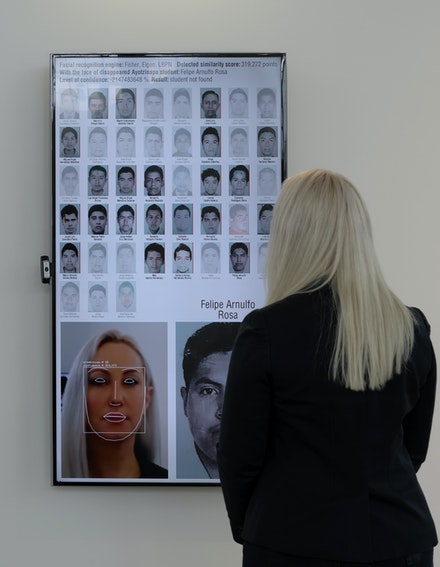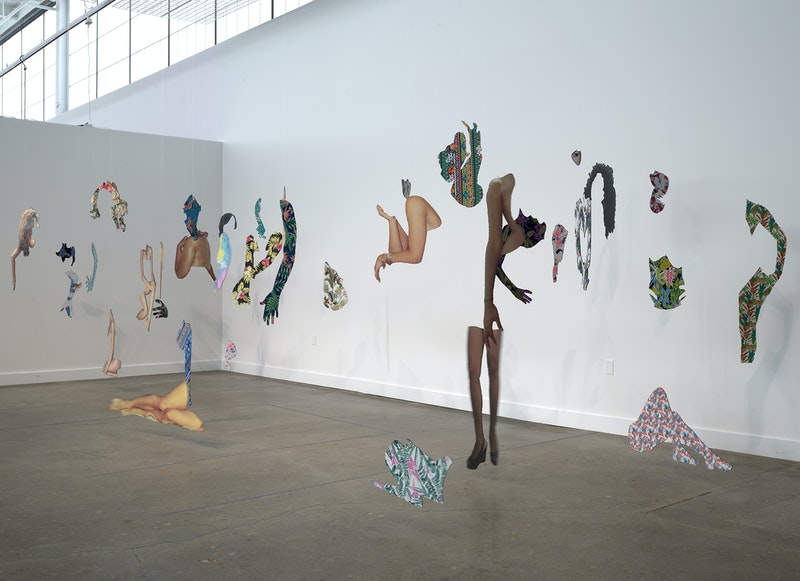
Machines have a history of generating identity formations with significant social implications. Buffalo is known as the “City of Light” because the electricity produced at Niagara Falls at the end of the 19th century made it possible to introduce street lamps, which stimulated its industrial boom. The illuminated urban environment transformed social interactions. Everywhere, electricity produced new work forces and identity formations—including stereotypical assumptions about aptitude and engagement.
Recognizing this is crucial to understanding the work presented in Difference Machines: Technology and Identity in Contemporary Art at the Albright-Knox in Buffalo, New York. The exhibition does not directly lean upon such histories, but even its use of a refurbished warehouse as venue—the museum proper is in construction—helps to expose how machines and their architectures produce social valences. The curators, Tina Rivers Ryan and Paul Vanouse, focus their broad agenda through four themes: the use of digital technologies for passive (but not always effective) surveillance, how identities are shaped by technology, the erasure of marginalized communities, and the active reassertion of control.
Hasan Elahi’s Thousand Little Brothers (2014) opens the exhibit with a floor-to-ceiling pigment-printed canvas of images that he took of himself and posted online in response to tracking by the FBI, who thought he was a national security threat after 9/11. This was before social media made such disclosures common. The curtain of color flows onto the floor, a reminder of the profuse data points amassed about each of us.

The adjacent alcove presents work about online surveillance from the 1990s by Keith Piper, an early canary of the social dangers that emerge from government mining of online content. Surveillances: Tagging the Other (1992) presents the conflict between racialized tagging online and (the British Left’s) efforts to be colorblind; the work foreshadows the threats posed by today’s facial recognition technologies. Blackness for Sale (2001) is a poignant early net-art work by Mendi + Keith Obadike in which they posted Keith’s “Blackness” for sale on eBay. Among these early classics are more recent ones like Stephanie Dinkins’s Conversations with Bina48 (2014–ongoing) and Zach Blas’s Facial Weaponization Suite (2012–14).
In Rafael Lozano-Hemmer’s Level of Confidence (2015) a webcam captures your face and provides the percentage match to one of 43 rural students who disappeared from a teachers’ college in Iguala, Guerrero, Mexico—my facial biometrics coordinated with Felipe Arnulfo Rosa. The students remain missing, despite the supposed efficacy of surveillance technologies. Artists featured here also use gamification to similarly implicate us in social issues, as in Danielle Brathwaite-Shirley’s We Are Here Because of Those That Are Not (2020) and A.M. Darke’s ‘Ye or Nay? (2020). Mongrel’s Heritage Gold (1997) was an early software that hacked Photoshop so that users could confront the racial possibilities in the application of facial filters.
The curators provide longer-than-usual wall text and a discursive catalogue essay to help audiences access the layered issues in the works included in this show. Sean Fader’s photographs for Insufficient Memory (2020) require understanding that he used a Sony Digital Mavica—one of the first popular digital cameras, dating from 1998—to memorialize the locations where LGBTQ-identifying people were murdered between 1999 and 2000 … while US Congress was debating the Hate Crimes Prevention Act. The camera’s smaller digital files produce impressionistic images when printed large. On the back of each one is the narrative surrounding the death. Fader also created an online Google Map to help others learn the histories that he drove 25,000 miles around the country to discover.
Similarly complex is Root Picker (2021), a bioreactor with digital video by bio-artist Rian Ciela Hammond about hormone technologies and the occluded histories of colonialism around pharmaceutical manufacturing. Hammond’s work includes a land acknowledgement statement to address that “the virtual landscapes we connect and navigate through, like the physical lands we occupy daily are equally contested lands. Built on continued legacies and practices of stolen land, legacies of slavery and forced removal of indigenous peoples.”

Walking through Joiri Minaya’s floating body parts of hyper-sexualized women in #dominicanwomengooglesearch (2016) emphasizes how our browsers influence cultural perceptions and reproduce unfortunate stereotypes. The dismembered figures that twist to reveal tropical print fabrics produce a maze of the interlocked histories of colonization, exoticization, desire, and capital reiterated across the web. Morehshin Allahyari’s works examines how digitization appropriates cultural heritage artifacts and asks difficult questions around digital colonialism.
Sondra Perry’s art often has a discomfiting humor and IT’S IN THE GAME ’18 or Mirror Gag for Projection and Two Universal Shot Trainers with Nasal Cavity and Pelvis (2018) is no different: this is a 16-minute video that addresses how the NCAA appropriated her brother’s image and sold it for use in basketball video games, making the assertion that his scholarship gave him no rights to his own image. Such an absurd claim is made possible by the colonial mentality of dispossession that filled so many museum collections.
Skawennati founded CyberPowWow as an online space that centers Indigenous artists, and in She Falls for Ages (2017) the artist films avatars in the virtual space Second Life to produce a retelling of the Haudenosaunee creation story. When “half of all American Indian/Alaska Native children lack either computers or paid high-speed internet access” (according to the Population Research Bureau census in 2020), Native and Indigenous content is less likely to appear online and so continues to be erased from the wider culture. Reclaiming these tools and spaces presents a wider array of histories and experiences across society.
Saya Woolfalk’s Landscape of Anticipation 2.0 (2021) offers a note of hopefulness. An entire wall is dedicated to nine digital videos that constitute various hybrid creatures from her society of mythic beings, the Empathics. These flora-fauna-human-alien beings offer an imaginary for co-living. A recognition of the pitfalls must be accompanied by consideration of the potential for emergent technologies to produce an equitable society, as many of their proponents claim.
Nostalgic desires for a world before computers or the internet don’t help us address the social and political effects of increased reliance on them. Difference Machines demands that audiences take seriously the presence and effect of these technologies. The family guide, the library at the back of the gallery, and the online resources that accompany the show provide support for those ready to engage with the work of wrestling our futures from technologies that reiterate old prejudices.
